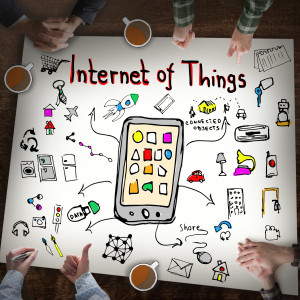WASHINGTON — California Republican Rep. Darrell Issa stopped into Microsoft this week to talk about one of the fastest growing parts of our increasingly connected, digital world — the Internet of Things (IoT) — with a room full of tech-savvy representatives from local government, Silicon Valley, the Commerce Department and even the White House.
“The Internet of Things really is about products, services and interconnected opportunities that didn’t exist a generation ago, and will be taken for granted by the end of this generation,” Issa, who chairs the House Judiciary Subcommittee on Courts, Intellectual Property and the Internet, told the crowd at the Microsoft Innovation and Policy Center in Washington Wednesday.
Issa said he was excited by the pace of growth of the Internet of Things — the growing network of physical objects like home entertainment systems (TVs, stereos), automated smarthome systems (lights, thermostats), automobiles, medical devices and more connected to the Internet and optimized for digital control.
The California representative added that government had helped facilitate its growth so far by, for the most part, staying out of the way.
“We want Congress to be educated by the people who are innovating,” Issa said. “Most members of Congress, when you talk about a mesh network, they go, ‘Okay, is that, how you stop spaghetti, when you’re draining it, from going down the sink?'”
“And I’m trying to be cute, but I’m not trying to be cute — it really is in fact something where they go, ‘What’s that?’ If you talk to people in the industries, in many cases they have no idea that there are developing standards, and that those standards will be rolled out very shortly.”
Issa recalled a meeting he had Wednesday morning with former Apple iPod division vice president and Nest founder and CEO Tony Fadell about his company’s groundbreaking IoT thermostat and smoke/carbon monoxide detector, which Google acquired along with Nest last January for $3.2 billion.
“Every Nest device has a full mesh network (a network comprised of nodes, or individual devices, in which each node is capable of sharing data across the entire network) embedded in it that will go live for products that today don’t exist,” Issa said.
“It’s in the hardware from day one. Why? because somebody who brought us the iPod and the iPhone understood that simple, single communication had become obsolete with the phone. That nobody wants a phone that only can make a cellular call — we want a phone that can make a cellular call while simultaneously moving data, while in fact playing music or anything else, on your bluetooth device — and that’s just three connections with one phone.”
The smarthome of the future, Issa said, will be comprised of dozens of automated, connected sensors and devices capable of, for example, accounting for the position of the sun and the light in the windows when heating and cooling certain areas of the house — all the while saving consumers more energy and money than a standard system.
Such innovation does carry risks — chiefly in the area of data breaches and spillage, which put the privacy and security of consumers at risk, as well as the intellectual property of innovators. While Issa conceded government has a role to play in protecting consumers, he said agencies like the Federal Trade Commission have been going about it the wrong way by punishing companies for breaches with outdated authority.
“They’re going to come in, they’re going to sue you administratively, and they’re going to demand a 20-year consent decree that will cost your company perhaps millions and millions of dollars, maybe more, to implement based not on the standard of what you did wrong — but based on the fact that you had a breach,” Issa said.
Issa told IoT innovators they need to take the initiative in going to government and asking lawmakers to step in and help establish a standard of best practices for safeguarding data — such as firewalls, encryption, etc. — and dividing the acceptance of risk between government, consumers and companies, as opposed to just the industry itself.
“But it shouldn’t lead to the victim being re-victimized,” Issa said. “The Federal Trade Commission and other federal agencies today will come after you, even though they can’t tell you what you should have done.”
“This is the same group that gave away a million veterans’ social security numbers. Then in fact, even after the State Department was hacked… They weeks later discovered they were still effectively being hacked because they couldn’t clean it. And the list goes on — the Department of Defense and agency after agency — it is not possible to be purely airtight.”
As another panelist pointed out, part of protecting consumer data means protecting it from the government itself, and setting the right example for the rest of the IoT global community. Microsoft itself is currently waging such a battle with the Department of Justice, which is trying to force the company to turn over user data stored in servers located overseas.
Issa said the answer to setting the right example was to continue supporting reforms like the U.S.A. Freedom Act, which disassembles the National Security Agency’s bulk phone data collection program justified under Patriot Act Section 215, and to push for further reforms to authorities like Section 702 of the 2008 FISA Amendments Act, which lets NSA target the content of communications overseas and in the U.S.
The chairman added that data is most-protected within the U.S.
“If you put your data overseas — quite frankly, you’re not protected by U.S. law. And if our agencies need data, they may come get it,” Issa said. “You put your data systems here, you’re going to be protected by court protection, and in fact, advocacy that you’re allowed to participate in.”

